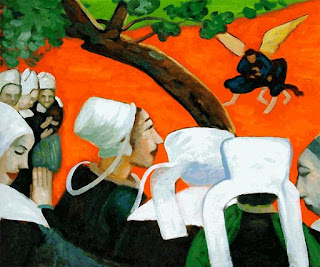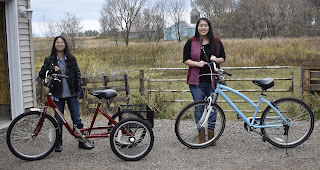His work was influential to many modern and French avant-garde artists, such as Henri Matisse and Pablo Picasso. Gauguin was an important person in the Symbolist movement as a sculptor, printmaker, painter, ceramist, and writer. He was an influential proponent of wood engraving and woodcuts as art forms.
In The Yellow House by Susan Rubin, the story is told about how Vincent Van Gogh missed the company of other painters, so he invited Paul Gauguin to come live with him in his Yellow House in Arles.
So, for two months, in Fall 1888, the two men painted side by side. Their artistic styles, however, were very different. Vincent painted what he saw around him; and Paul painted from his memory and imagination. Vincent painted quickly, while Paul worked on paintings over a period of time. Vincent was messy and disorganized, and Paul was tidy and organized.
Below are six paintings that Paul Gauguin created. Olivia studied each of them and shared some things that she remembered about them.
Peasant Woman and Cows in a Landscape
Watercolor, 1889
Private collection
Olivia remembered:
- There are two cows and a woman.
- One cow is black and white; and the other is brown and white.
- The cows appear to be milk cows; and it appears the woman is getting ready to milk the black one.
- In the background, you can see some trees that look they are on top of a slight hill.
- The trees look very odd - they look like really misshapen potatoes with horns or arms sticking out of them.
- One of the trees looks like it could be a person with two horns sticking out of their head.
- There is a brick wall that looks like it has been made into the side of the hill.
- The woman is wearing a white cap, a white shirt with a skirt over it; and she looks like she is wearing a yellow apron.
- There are some clouds in the distance that look like they are storm clouds.
- There are also some black spots that are on the top of the picture by the trees that looks like some black paint was spilled on it.
- There are these spots on the trees that look like a hand...sort of.
- There are some flowers on the hill as well.
- The ground looks like it is a dirt road or just dirt on the road.
- It looks like summer with flowers that have already bloomed. The trees are mostly bare, but there are a couple of branches that look like they have leaves on them.
Night Café at Arles
Oil on jute, 1888
Pushkin Museum, Moscow, Russia
Olivia remembered:
- There are seven people in the picture. One is the owner of the café and the other six are customers.
- One has a mustache. Another one has their arm on the table with their head on it. The other four are sitting at a table together and it looks like they are having a conversation together.
- In front of the customers and behind the woman, is a pool table. Underneath it, by the leg of it, is a cat.
- There are three pool balls on the table; two are white and one is red.
- The woman appears to be standing in front of a table or counter, and she has one hand resting on the table and the other propping up her head.
- She has her head slightly tilted so she can see the customers.
- There are two bottles on the table next to her - one is made from blue glass and the other one is green.
- On the wall behind the table is a picture. The only thing I can point out in the picture is a lamp.
- Someone or several people in the café is smoking because you can wisps of smoke.
- The walls are brown on the bottom half and the other half is bright red.
- The owner (the woman) is wearing a white shirt with what looks like a long black dress over it.
- The woman has black hair and the people appear to have brown or black hair.
- On the table with the four people, you can see some bottles.
- Two of them appear to be Asian.
- The cat is white with some black and brown spots.
- You can't tell where the light is coming from, but you can see the shadow of the pool table on the ground.
Old Women of Arles
Oil on canvas, 1888
Art Institute of Chicago, Chicago, Illinois
Olivia remembered:
- There are four women in the picture, two trees, a pond or lake, and a red picket fence.
- Next to the fence is this big green thing that looks like boulder that looks like it is covered in moss and has a face on it.
- The women all have blue or black shawls on it that makes them look like kimonos and have little hats or bows on their heads.
- On the pond you can see the reflection of the shore and the sky with a cloud in it.
- There is also this weird thing in the middle of the cloud's reflection in the water that looks like a lily pad in the shape of a top hat with white spikes coming out of it.
- There is a white path and the two women in the background are walking on the grass.
- In the left corner of the picture, you can see some tree branches hanging down.
- You can't see the top of the two trees on the grass. You can just see the trunks.
- The two women that are closest that you can see have their hands folded under their shawls.
- The fence is made out of wood.
- The women all have blank or calm and peaceful looks on their faces.
The Vision after the Sermon - Jacob Wrestling with the Angel
Oil on canvas, 1888
The National Gallery of Scotland, Edinburgh
Olivia remembered:
- In the picture, there is a man fighting with a person with wings also known as an angel.
- They are surrounded by a bunch of nuns who are in a circle.
- Some of the nuns are sitting with their hands in their laps while two look like they are having a conversation. One appears to be praying.
- There is a cow or what I think is a cow in the picture; and kind of splitting up the circle is a tree.
- This tree has green across the top of it and looks like it is very durable.
- The man who is wrestling with the angel and losing has black hair and a beard.
- Both the angel and him are barefoot, and are dressed in the same black robes as the nuns, except they don't have the white thing around their necks or the white ear flaps.
- The ground of the picture is red. I think they are outside.
- One of the nuns looks unhappy because she is looking towards the two who are talking and she has a look of displeasure on her face.
- The angel's wings look like they are a golden-bronze color.
- The cow is brown with small light-colored spots.
Portrait of Van Gogh Painting Sunflowers
Oil on canvas, 1888
Van Gogh Museum, Amsterdam
- In the picture, you have Van Gogh sitting on a stool painting.
- On the stool or table there is a vase of sunflowers and his palette with paint and paint that looks like it has been mixed.
- On the walls in the background are light blue.
- Van Gogh has brown hair with a red beard.
- There is a window behind him. Out of the window, you can see trees and another wall, and a yellow path - or something that is long and yellow.
- Next to his painting there is another easel, but you can't see what's on it. It looks like it is taller - possibly - than the other easel and maybe a bigger canvas.
- Van Gogh is wearing a full suit that is a little bit lighter than his hair color. His shirt is white and he may be wearing a bow tie and a waist coat and jacket. The waist coat, jacket, and pants all match.
- Two of the sunflowers towards the bottom are short. They are very dark in color and it looks like they are hanging down.
- The sunflowers kind of look sad in the blue vase.
- The table looks like it is made out of wood and it has slats - like an outdoor table.
- The paint on the palette is blue and white. The white paint is bright, and the blue paint is dark. It looks like he is mixing the white paint with the blue paint to get a lighter blue. Maybe to do the face.
- He is holding a paint brush in his hand. He could have been just holding it and looking at his picture.
Christmas Night, The Blessing Of The Oxen
Oil on canvas, 1902-1903
Indianapolis Museum of Art, Indianapolis, Indiana
Olivia remembered:
- The picture has two cows and six people in it.
- Two people look like statues...and they may be statues.
- The other four people are standing around the cows - 2 standing in between them, 2 standing on the outside looking at the women.
- They all have their heads wrapped up in scarves or shawls to keep the cold out.
- One of the cows is black and white. The other one looks like it could be white with a palomino color.
- The black one has two white stockings (markings) on the front feet.
- Behind the women and the cows, there are some buildings. Two look like they are houses and one looks like a church.
- Behind the houses, there looks like there is a hill or an island because in the distance there looks like there is a river or lake. On the other side of the lake's shore is another city with a church.
- You can tell it is late in the evening because it looks like the sun is starting to set.
- The ground that the cows are standing on has snow on it and a dirt path. The snow kind of has a greenish tint to it.
- The two figures to the right of the picture are on this covered section that is stone and has two steps. They look like they could be statues.
- The sky was kind of orange at the horizon line.
- It is a bright picture, but at the same time it could be a dark picture.
- The two statues are taking cover underneath a half-dome.
- The two women who are standing in between the cows don't have legs. It looks like they weren't painted in.
- The two women who are standing in between the cows are facing one another so you can't see their faces.
- The woman by the face of tan cow looks tired - she has an aura of exhaustion around her.


















































